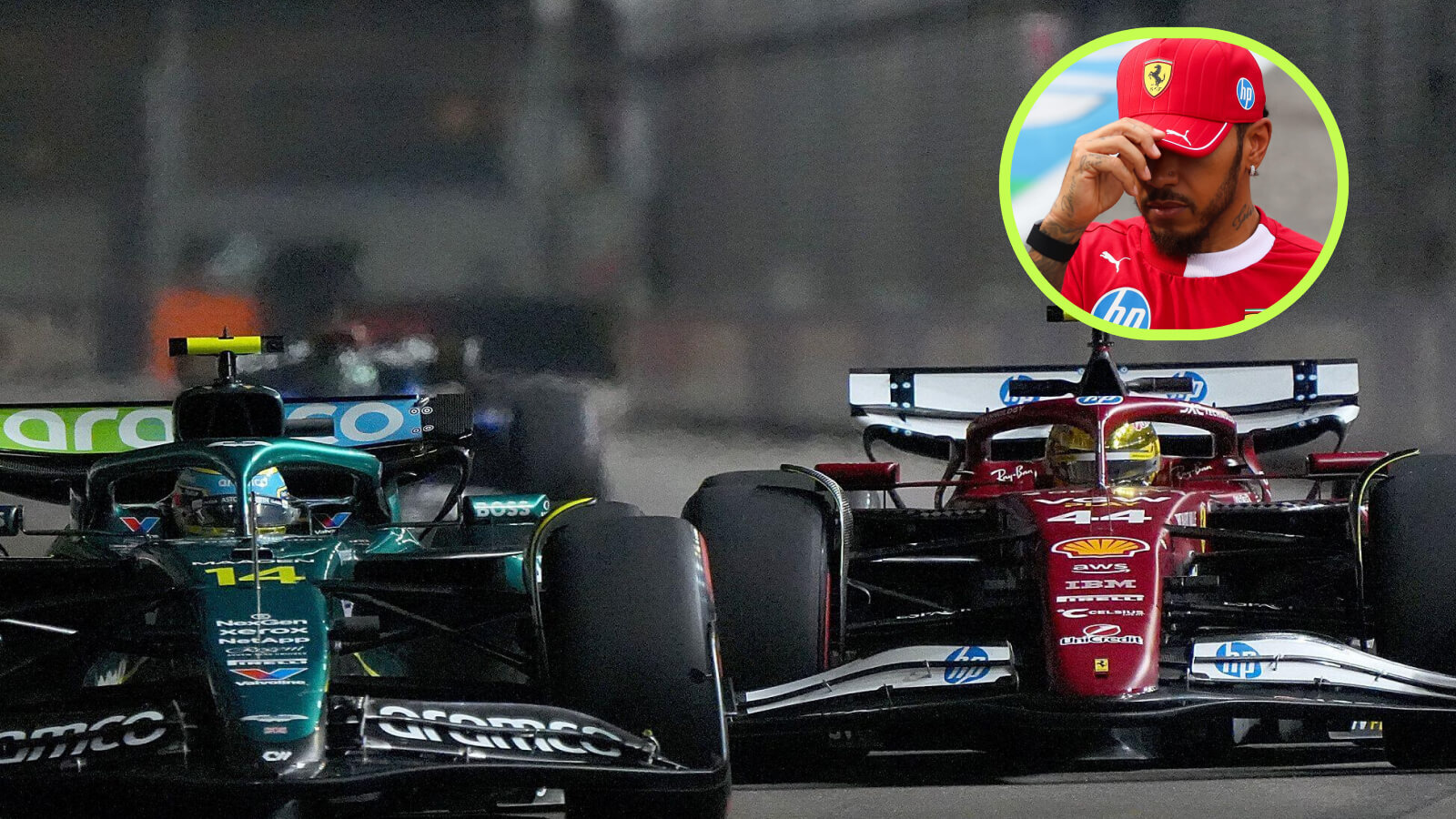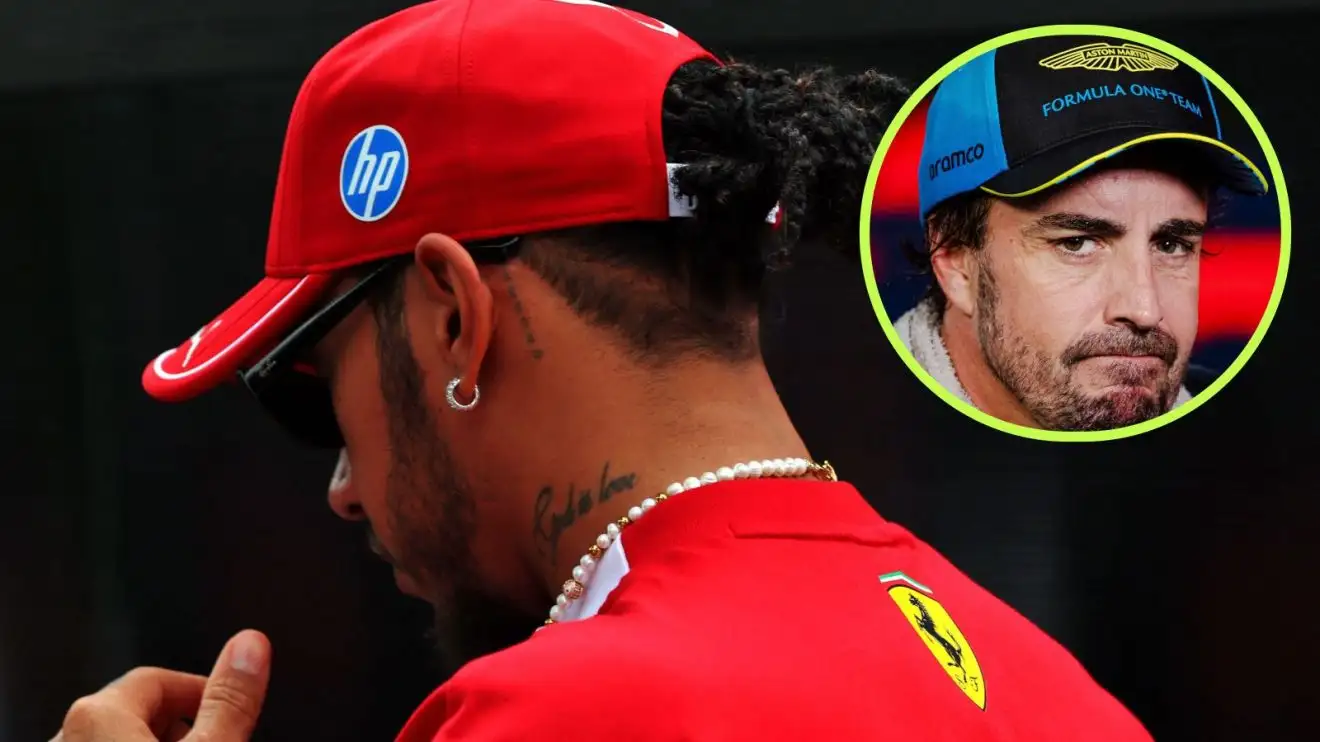In the high-octane theater of Formula 1, where drama unfolds at 200 miles per hour, the Singapore Grand Prix delivered a spectacle of controversy, tension, and masterful spin.
What began as a seemingly clear-cut case of a driver piloting an unsafe vehicle quickly spiraled into a complex web of accusations, driven defenses, and a war of words between two of the sport’s most iconic figures: Lewis Hamilton and Fernando Alonso.
The incident at Marina Bay, which saw Hamilton’s Ferrari limping with failing brakes and Alonso crying foul over the radio, became the weekend’s biggest talking point.
However, when the dust settled, the bombshell revelations from Hamilton and Ferrari boss Frédéric Vasseur didn’t just counter Alonso’s claims—they completely reshaped the entire narrative, exposing a hidden crisis that had plagued the Scuderia from the very start.

The scene was one of controlled chaos. Under the dazzling lights of the Marina Bay Street Circuit, one of the most physically and mechanically demanding tracks on the calendar, Lewis Hamilton’s SF-25 was visibly struggling. Corner after corner, the seven-time world champion was missing his apexes, running wide, his car refusing to stop as commanded. Behind him, Fernando Alonso watched the faltering Ferrari with a mixture of disbelief and escalating fury. From his cockpit, the situation was untenable: a rival, with what appeared to be almost no braking power, was being allowed to remain on track, posing a potential danger to everyone around him.
Then came the radio transmission that echoed across social media and the F1 paddock, a moment of pure, unfiltered rage that only a driver like Alonso could deliver. “Is it safe to drive with no brakes?” he screamed to his Aston Martin pit wall, his voice rising in pitch and intensity. “Five seconds minimum! You cannot drive when the car is not safe!” It was vintage Alonso—passionate, righteous, and utterly incensed. Within moments, his words became the defining story of the race. The optics were damning for Ferrari. Their star driver, a global icon, appeared to be recklessly navigating a treacherous street circuit in a compromised machine, and the FIA’s subsequent decision to hand Hamilton a five-second penalty for leaving the track and gaining an advantage seemed to validate Alonso’s outrage. Case closed, or so it seemed.
But in Formula 1, the story told by the television cameras is often only a fraction of the truth. What unfolded in the post-race media scrums was a masterfully executed counter-narrative, led by a composed Hamilton and a armed Vasseur. Far from offering an apology, they systematically dismantled the accusations, piece by piece, revealing a story not of recklessness, but of remarkable crisis management under extreme pressure.
Hamilton’s initial response was measured, almost understated, a stark contrast to Alonso’s fiery outburst. He acknowledged the dramatic brake failure but firmly insisted that he had been in control throughout the ordeal. His own in-race radio messages painted a picture of a driver actively managing a critical failure, not succumbing to it. “I was trying to cut corners,” he had told his engineer, the frustration in his voice palpable, yet his driving remained precise under the circumstances. For Hamilton, the suggestion that he had endangered his fellow competitors was not just unfair; it was a fundamental misreading of the situation. He had slowed his pace massively, losing over 30 seconds to the race leaders in the final laps. This wasn’t a driver pushing the limits of safety; it was a veteran of the sport doing everything in his power to nurse a wounded car home.

This is where Frédéric Vasseur stepped into the fray, armed with something Alonso didn’t have access to from his cockpit: terabytes of telemetry data. The Ferrari team principal, with a calm and unwavering demeanor, laid out the facts. “In terms of safety, yes, it was under control,” Vasseur stated firmly, explaining that Hamilton’s pace had been intentionally and drastically reduced precisely because of the brake issue. “Lewis slowed down massively. It was on the safe side.” Then, with a subtle chuckle that spoke volumes about Ferrari’s confidence in their position, he added that while being 30 seconds off the pace was far from ideal, the team’s priority was always safety. That small laugh wasn’t a sign of arrogance; it was the sound of composure, of a team that knew they had the data to back up their claims. Ferrari wasn’t retreating; they were pushing back with irrefutable facts.
However, the most stunning part of Ferrari’s defense was not about the final, dramatic laps. It was a revelation that completely reframed the entire race for both of their drivers. Vasseur disclosed that the brake failure wasn’t a sudden, isolated incident. Instead, it was the catastrophic climax of a race-long battle against overheating issues that had affected both Hamilton and his teammate from the very beginning. “We had to lift and coast for most of the race,” Vasseur admitted, detailing how both drivers were instructed to manage brake and tire temperature spikes from as early as the second lap. They were constantly adjusting their braking points, backing off the pace, and trying to keep the car’s vital signs out of the red zone. This wasn’t a story about one driver’s brakes failing at the end; it was a story about a team-wide crisis that had been meticulously managed for 95% of the Grand Prix. “When we pushed for a few laps, the pace was decent,” Vasseur explained, a hint of exhaustion in his voice, “but you can’t do 95% of a race on the back foot.”
Hamilton’s own post-race comments subtly reinforced this hidden narrative. “It’s not like I was pushing like hell,” he said with a wry smile, a sharp yet understated comment that highlighted how profoundly the external perception differed from the internal reality. This wasn’t a driver losing control; this was a world-class athlete engaged in a delicate, high-speed balancing act, nursing his car while executing precise team instructions for nearly two hours.
This new context raises a fascinating question: was Alonso wrong to be furious? From his perspective, seeing a rival car repeatedly miss braking points, the answer is no. His concern for safety was justified based on the visual evidence available to him. Yet, was Hamilton wrong to feel aggrieved by the accusations? With the full knowledge of Ferrari’s data and their race-long strategy, the answer is also no. He was managing a critical situation with immense skill. It was a classic case of two drivers seeing two completely different versions of the same race, a perfect storm of perception versus reality.
The FIA’s five-second penalty only added another layer of complexity. The stewards justified the penalty by stating that a mechanical issue was not a valid reason for leaving the track, treating the incident as a standard track limits violation. But this rigid interpretation sparked debate: can a sudden mechanical failure that robs a driver of stopping power truly be equated with a simple misjudgment of a corner? Hamilton, wisely, did not contest the penalty. In the political minefield of Formula 1, challenging the governing body after such a chaotic race would have been counterproductive. Instead, he let his composure and his team’s driven defense do the talking.
The F1 paddock, predictably, was split. Some sided with Alonso, calling for unwavering consistency from the FIA on safety matters. Others rallied behind Hamilton and Vasseur, praising their professionalism and restraint under immense pressure. What made the entire affair so compelling was its raw, human element. It pitted two legends, former teammates and fierce rivals, against each other, each embodying a different approach to chaos—Alonso with his fire and brimstone, Hamilton with his cool, defiant poise.
In the end, what may have tipped the public narrative in Hamilton’s favor was his tone and a final, masterful move in the court of public opinion. Throughout the controversy, he remained unflappable, projecting a quiet certainty that he had done the right thing. This mature approach resonated with fans who have witnessed his evolution from a fiery rookie into a composed elder statesman of the sport. Then came the checkmate: a playful Instagram post referencing the phrase, “I don’t believe it,” a direct and cheeky wink at Alonso’s furious radio message. It was a bold, clever, and quintessentially British move that disarmed the situation, transforming a potentially bitter feud into a moment of light-hearted rivalry. It showed he wasn’t rattled; he was amused. He had taken one of the weekend’s most heated moments and turned it into viral content—a victory in itself in modern Formula 1.
The Singapore saga leaves us with lingering questions. Will the FIA be forced to clarify its stance on mechanical failures versus track limits? Will Ferrari’s persistent brake temperature issues continue to be their Achilles’ heel at high-stress circuits? And perhaps most tantalizingly, is this the spark that will reignite the legendary rivalry between Hamilton and Alonso, taking us back to the explosive intensity of their shared 2007 season? Only time will tell, but one thing is certain: this season is far from over.
